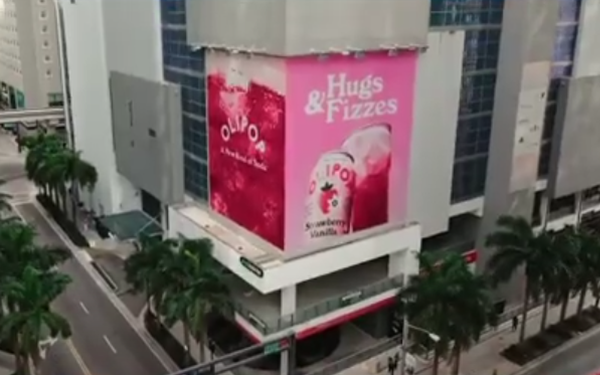Commentary
Olipop On The Power Of Digital OOH
- by Danielle Oster , Staff Writer, April 12, 2024

Better-for-you soda brand Olipop has been disrupting the category with a low-sugar alternative to the industry’s big players, and building a brand voice through social media as well as connecting to cultural moments (like appearing in a Nikki Minaj and Ice Spice music video last year).
At Marketing Daily’s recent Digital Out-Of-Home Insider summit, Olipop director of integrated media Sarah Leidy Kelly discussed the role of DOOH in the brand’s marketing strategy in her keynote, “Unlocking the Power of DOOH for a 360-Campaign Strategy.”
Kelly explained she was tasked with scaling the “Real Love Makes Us” brand platform that Olipop introduced last year, primarily through digital OTT and CTV.
“When looking at all the media channels, I naturally went to out-of-home specifically because I knew it was a way to build brand awareness at scale,” Kelly told audiences at the summit. “Secondarily, it’s important for us to measure in-store foot traffic to our retailers, because now a majority of our distribution comes through retailers.”
“We knew we had to drive foot traffic as well as brand awareness, so that's really where we leaned in on out-of-home, and specifically digital out-of-home,” she added.
To test their DOOH strategy, the brand did a test run in Chicago, a city selected for strategic reasons as the brand seeks to build its customer base outside of the coastal cities where it’s more established.
“We wanted to focus on the middle of the country because we knew there was a long runway for us of people who were potentially open to a healthier soda but may not know what's out there,” she explained.
Another reason they chose the city was its business districts with ample space for DOOH, focusing on areas frequented by tourists and business commuters. “We wanted everyone to see us and feel like we were part of the community,” Kelly said.
To that end, Olipop partnered with a local artist on a mural representing the city through landmarks and its celebrated hot dogs to create a “crave-worthy art piece” associated with the company.
“We also infused other digital elements with our buy. We have the data on people who have been in the neighborhoods of our billboards, and so most likely have seen our billboards,” Kelly said, explaining that the brand took those data sets to develop a local Chicago ad with the tagline “You’re doing great, Chicago,” using local slang and references.
In addition to OOH, the campaign included an influencer activation, PR elements, and local event sponsorships.
According to Olipop, the campaign resulted in more than 35 million impressions, 90% ad likeability, 80% improved opinion of Olipop, 117,000 in-store visits to retailers, a 4% increase in sales and 1.3% increase in household penetration.
“We saw that sustained increase in sales and household penetration,” Kelly said, noting this came despite the end of the year typically being a seasonally low period for the category.
Kelly acknowledged the trail run wasn’t perfect, and the brand learned some valuable lessons.
“Where we fell short was including all the stakeholders, our sales team in particular, to make sure we were matching our level of marketing in the market” and make the most of point-of-sale and retail, she explained. Another takeaway was to consider all touchpoints. “We had a few activations outside of out-of-home, but it wasn’t a true 360 yet,” she added.
Olipop took these lessons and applied them to a 2024 campaign rollout, which kicked off in Miami this past February, and that Kelly said was “10 times bigger and better” than the Chicago activation.
“It was a full 360 strategy this time,” she said, starting with the baseline of OOH, and using it as a “connection point for all other channels to lock into,” with the brand buying a variety of OOH elements – including digital boats running along Miami’s beaches, a double-decker bus wrap in the city featuring an influencer partnership, and another partnership with a local artist.
It also took its digital reengagement strategy to the next level.
“With Chicago, digital reengagement was just this flat banner that spoke to Chicago and led to [our website,] and urged people to use our store locator,” Kelly said. For Miami, Olipop used a digital coupon to target audiences that the company knew likely saw its billboards.
“It was the coupon that really drove more sales, because [audiences] were incentivized to purchase,” Kelly explained. She called the increased retailer match a “main takeaway” of the campaign, with retailers increasing their orders by 3x. “We really armed our sales team with this marketing strategy for a pitch point to go to the retailers and prove our commitment and investment into the market.”
Kelly noted the target demographic was 25- to 54-year-olds, focusing on audiences where “someone is in the household income range to be able to afford our product,” with those parameters informing which neighborhoods the brand selected for the campaign.
The brand also emphasized an enhanced presence in Miami on digital retail channels for its retail partners.
Some of the overall takeaways from the brand’s campaign that Kelly shared were the need to take advantage of ad tech; find ways to “[infuse] tech into a traditional placement;” connect to a 360 campaign that tells “one consistent storyline;” and focus on the visual storytelling benefits of OOH.


